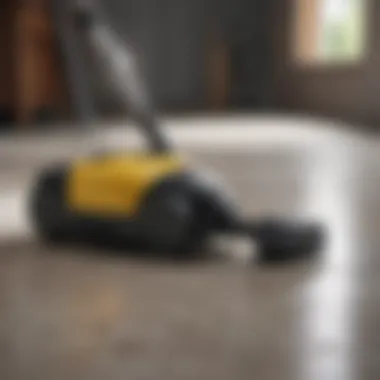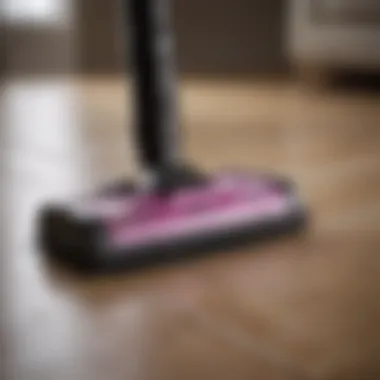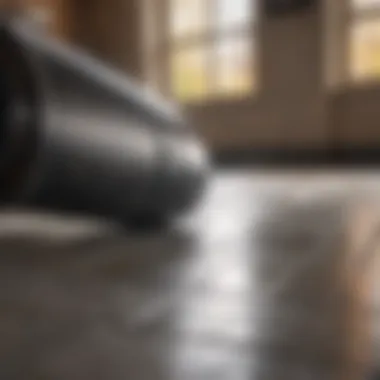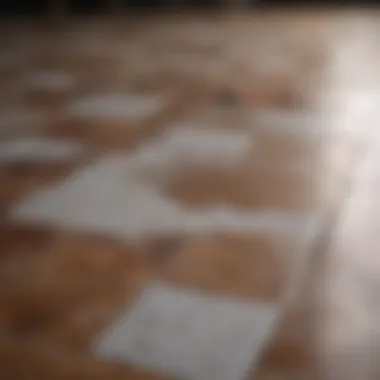Ultimate Guide to Choosing a Vacuum for Tile Floors and Pet Hair


Intro
Selecting a vacuum cleaner might seem straightforward, but the task becomes complex when the emphasis lies on maintaining clean tile floors alongside managing pet hair. Many vacuums claim to be ideal solutions for both tasks, yet not all deliver the promised performance. This article provides a detailed examination of the features and technologies that are crucial when choosing the best vacuum for tile floors, particularly in homes with pets.
Effective cleaning involves more than just suction power. The design and style of the vacuum play significant roles. For users, understanding their specific needs like floor type and pet hair behavior is essential. This guide will explore relevant options, highlighting the importance of personalization in vacuum selection. Strategically choosing a vacuum can significantly enhance the cleanliness of living spaces, particularly in households where pets reside.
Fascinating Facts About Pets
Unique Characteristics
Pets, especially cats and dogs, possess unique grooming habits that result in loose fur. This fur often ends up on tile floors, creating a need for effective cleaning solutions. The variety of pet breeds also influences the amount and type of hair shed. For instance, long-haired pets may require different cleaning approaches compared to their short-haired counterparts. Heater, humidity, and seasonal changes may also affect shedding rates, showcasing the intricacies involved in managing pet hair.
Extraordinary Abilities
Pets also demonstrate remarkable abilities when it comes to detecting dirt and excess hair accumulation. Their keen sense of smell may indicate areas needing cleaning, making it vital for vacuums to effectively remove hair and dander to maintain a healthy living environment. An understanding of these abilities can guide customers in choosing products that cater to their pets’ unique requirements.
The Importance of Specialized Vacuums
Using a vacuum specifically designed for tile floors is crucial due to the nature of the surface. Tile floors are slippery, making it difficult for traditional vacuums to maintain traction. Specialized features like rubberized wheels and lightweight constructions enhance stability and maneuverability. Additionally, varried suction settings may be beneficial in adapting to dust and pet hair, ensuring that the vacuum serves efficiently across different floor types.
Key Features to Look For
When searching for a vacuum for both tile floors and pet hair, several features warrant consideration:
- Suction Power: Strong suction is essential for pulling up hair and dust.
- Brush Roll Design: Tangle-free or detachable brush rolls are advantageous to avoid hair wrapping.
- Filter System: HEPA filters can trap allergens and improve air quality.
- Weight: Lighter vacuums enhance ease of movement across various surfaces.
Understanding the Needs of Pet Owners
Pet ownership brings joy and companionship, but it also introduces several cleaning challenges. For owners, keeping a home tidy can be a daunting task, especially when tile floors are involved. Tile can be durable and attractive, but the combination of tiles and pet hair presents unique challenges that need careful consideration.
The Challenges of Pet Hair on Tile Floors
Pet hair can accumulate rapidly on tile surfaces. Unlike carpets, where hair can sink in, tile flooring allows hair to sit on the surface and become more visible. Additionally, the static charge on tile can cause pet hair to bind tightly to the surface, making it challenging to remove. This necessitates a vacuum cleaner that effectively tackles loose hair without scratching or damaging the tile.
Furthermore, cleaning pet hair from tile can involve more than just the obvious amounts of fur. Pet dander and other debris can also contribute to a decline in indoor air quality. A vacuum designed for tile floors must have high filtration capabilities to capture these particles, benefiting both pets and their owners.
Why Tile Floors Require Special Consideration
Tile floors, while easy to clean, require specific cleaning techniques to maintain their luster and integrity. Many conventional vacuums may not be suitable for tile. Hard bristle brushes can scratch the surface, harming the tile's finish. Therefore, a vacuum with a soft brush roll, or the option to remove the brush, is beneficial.
Moreover, some tile surfaces can be slippery, so lightweight and maneuverable vacuum cleaners are essential. A cumbersome device can become impractical, leading to a lack of cleaning motivation. It is important that pet owners select a vacuum that not only adapts to tile floors but enhances their efficiency in cleaning.
By understanding these needs, pet owners can make informed choices about vacuum cleaners that will effectively manage pet hair while keeping their tile floors in excellent condition.
Key Features of an Effective Vacuum for Tile Floors


When selecting a vacuum for tile floors, especially in homes with pets, certain features directly impact cleaning ability and user experience. Not all vacuums are made equal, and understanding the specific attributes that enhance performance can aid in making a well-informed choice. Each feature plays a crucial role in ensuring that both tile surfaces and stubborn pet hair are attended to effectively.
Suction Power and Efficiency
Suction power is the primary function of any vacuum. For tile floors, it is essential to have strong suction to pick up dirt, debris, and pet hair. Effective suction not only enhances cleaning efficiency but also prevents the scattering of hair into corners or onto other surfaces. High suction power combined with advanced engineering ensures that pet owners can protect their homes from continuous cleaning struggles. Efficient vacuums manage energy consumption while maximizing performance, yielding better results in a shorter amount of time.
Brush Roll Design for Hair Removal
Brush rolls designed specifically for hair removal are crucial for effective cleaning in homes with pets. It is necessary to consider the type and configuration of the brush roll. A tangle-free brush design minimizes hair wrap, allowing for smoother operation and prolonging the life of the vacuum. Some brush rolls have specialized bristles that loosen and lift pet hair from both tile and adjoining surfaces. Ensuring a quality design in this area will greatly enhance the overall cleaning experience.
Filter Types and Their Importance
The filter is a vital component, particularly when dealing with pet dander and allergens. Proper filtration keeps the air in your home cleaner, vital for those with allergies. HEPA filters are highly recommended due to their ability to trap finer particles and allergens. Maintaining a clean filter is paramount; clogged filters reduce suction and efficiency. Choosing a vacuum with easily accessible filters allows for straightforward maintenance, ensuring optimal performance over time.
Weight and Maneuverability
A vacuum's weight can determine how easily it can be used around the home. A lighter model allows for greater maneuverability, making it easier to navigate tight spaces, especially in homes with multiple floors. Additionally, the vacuum's design should facilitate easy handling without compromising stability. Models that allow smooth gliding across tile surfaces without the heaviness provide a comfortable cleaning experience, reducing fatigue during prolonged use.
Accessories and Attachments to Consider
Including essential accessories and attachments can significantly enhance your vacuum's versatility. For instance, a floor brush designed for tile surfaces can effectively reach corners and edges. Pet hair attachments, such as mini turbo brushes, are excellent for cleaning upholstery and vehicle interiors where pet hair often accumulates. Additionally, crevice tools enable access to tight areas where dirt tends to gather. Prioritizing vacuums that come with useful attachments makes a notable difference in cleaning efficiency.
Investing in a vacuum that combines strong suction, effective brush design, proper filtration, and convenient accessories leads to a more thorough cleaning experience.
Types of Vacuums Suitable for Tile and Pet Hair
Choosing the right type of vacuum cleaner is essential for effectively managing pet hair on tile floors. Different types of vacuums provide distinct advantages based on features, functionality, and ease of use. Understanding these differences allows pet owners to select a cleaner that meets their unique needs. An ill-suited vacuum may struggle with suction power or maneuverability. By focusing on various types of vacuums, you can tailor your cleaning approach, ensuring that both tile floors and pet hair are handled efficiently.
Canister Vacuums
Canister vacuums are versatile options for households with pets and tile floors. They consist of a separate canister that houses the motor and dust collection, connected to a long wand and nozzle. This design allows for easy maneuverability around furniture and tight spaces.
One of the main benefits of canister vacuums is their powerful suction capability. They are often more effective at picking up pet hair from versatile surfaces, including tile, compared to other types, such as upright vacuums. Many models also include specialized attachments for various cleaning tasks, like upholstery and stairs. This versatility can aid in maintaining a clean environment, crucial for the allergy-prone pets and their owners.
Upright Vacuums
Upright vacuums are popular for their ease of use and powerful suction. They are designed for larger cleaning areas and can cover more ground in less time than other types. Many upright models offer features like rotating brush rolls, which can effectively dislodge pet hair from tile surfaces.
These vacuums typically have a larger dust container, allowing longer periods of use without needing to empty. They can be very effective when tackling stubborn debris. However, they may be heavier and less maneuverable in tight corners than canister vacuums, which is something to consider if your home has several obstacles.
Robotic Vacuums
Robotic vacuums introduce automation to the cleaning process. These devices move autonomously and are programmed to navigate spaces while cleaning. They can be particularly beneficial for daily maintenance of tile floors and picking up loose pet hair. Robotic vacuums work well as a supplementary cleaning tool, rather than a sole solution.
While their suction power may not match that of larger, traditional vacuum types, they provide convenience and ease of use. Many models can connect to smartphone applications, allowing for scheduling cleanings while you are away. This feature is beneficial for busy families or pet owners who need extra help managing pet hair.
Handheld Vacuums


Handheld vacuums serve as excellent complementary cleaning tools, particularly for quick clean ups or localized messes. They are lightweight, portable, and typically equipped with specialized attachments, making them easy to maneuver in tight spaces. Their small size allows for easy storage and quick access when needed.
While handheld vacuums may not replace a full-sized vacuum for thorough cleaning, they can efficiently capture pet hair and dirt directly on tiles, furniture, and in the car. Their utility lies in their convenience, allowing users to address spills or pet accidents without lugging out a larger unit.
Considerations for Selecting a Vacuum Cleaner
Choosing the right vacuum cleaner involves careful thought beyond simply picking one off the shelf. This section highlights key aspects to consider when selecting a vacuum that efficiently cleans tile floors and manages pet hair. Several factors impact both the performance and functionality of vacuum cleaners, making it crucial for consumers, especially pet owners, to be well-informed.
Budget Constraints
Budget constraints play a significant role in determining which vacuum cleaner one can purchase. Prices can vary dramatically based on features, brand reputation, and technology. Here are some considerations:
- Assess Your Needs: Before making a purchase, clearly define what you need from a vacuum. If you have multiple pets or larger tile areas, investing in a higher-priced model with strong suction and specialized attachments for pet hair might be worthwhile.
- Long-Term Savings: A cheaper model may seem appealing initially but might result in higher long-term costs through repairs or repeated replacements. It is often more economical to invest in a more reliable model.
- Compare Prices: Explore options through online retailers, local stores, and second-hand markets. Researching different vendors can often provide a clearer picture of what each product offers for the price.
Brand Reputation and Reliability
Understanding brand reputation can enhance your purchasing decision. Some brands have established themselves as leaders in the market due to consistent quality and performance. Consider the following:
- Consumer Reviews: Look for user testimonials and expert reviews to gauge the reliability of specific vacuum models. Websites like Reddit and various home appliance forums offer valuable insights.
- Established Brands vs. New Entrants: Well-known brands often undergo rigorous testing and have a proven track record of quality. Newer brands might offer innovative features but may lack reliability.
- Professional Recommendations: Consult with professionals, such as veterinarians or cleaning companies, who may have experience using various models and can share insights into their performance.
Warranty and Service Options
A warranty is an indication of a manufacturer’s confidence in their product. Evaluating the warranty and service options available is essential:
- Length of Warranty: A longer warranty period usually reflects the manufacturer's assurance regarding durability. Look for vacuums that offer at least a two-year warranty.
- Service Options: Check if the brand offers useful customer service. Ideally, there should be easy access to support for maintenance needs or any required repairs.
- Replacement Parts: Consider whether replacement parts are readily available. Brands that provide easy access to parts can save you time and money in the long run, ensuring the vacuum stays functional.
Investing time in understanding these considerations will lead you to a vacuum cleaner that meets your specific needs, ensuring a cleaner, more pet-friendly home.
Maintenance Tips for Optimal Performance
The functionality of a vacuum cleaner directly correlates with regular maintenance. For pet owners and tile floor caretakers, maintaining optimal performance is crucial. Ignoring maintenance can lead to inefficiency, reduced suction power, and eventual damage. Here are foundational aspects to consider.
Regular Cleaning of Filters
Filters play a pivotal role in a vacuum's ability to trap dirt, allergens, and pet hair. Regular cleaning ensures that airflow remains unobstructed.
- How often? Aim to clean your filters every month, or more frequently in homes with pets. Dirty filters can significantly diminish suction, making your vacuum less effective.
- Types of filters: Be aware of the type of filter in your vacuum. Some are washable, while others need replacement. Check the manufacturer’s guidelines for specific cleaning instructions.
- Signs of neglect: If you notice decreased performance or increased noise, it is likely due to clogged filters. This can lead to overheating and potential damage.
Brushing and Cleansing Pet Hair
Pet hair tends to get tangled in various parts of the vacuum, especially brush rolls. Regularly removing pet hair is essential to ensure effective cleaning.
- Brush roll checks: Inspect and clean the brush roll often. Use scissors to cut away matted hair gently. This keeps the vacuum functioning smoothly and prevents strain on the motor.
- Soft brushes: Consider a vacuum that has a soft brush or a pet-friendly attachment. This can help in removing hair without scratching the surface of your tiles.
- Cleaning method: A damp cloth can be used to wipe down any remaining residue from the brush rolls, enhancing overall performance.
Preventive Measures Against Blockages


Blockages can drastically reduce a vacuum’s efficiency. Knowing how to prevent these issues is key to preserving performance.
- Regular inspection: Regularly check hoses and entries for obstructions. Common culprits include small toys, foreign objects, and excessive pet hair. Clearing these immediately can save time and repair costs later.
- Use the right attachments: Ensure you are using the correct tools for your cleaning tasks. This prevents blockages and ensures comprehensive cleaning of pet hair and debris.
- Educate household members: Teach everyone in the household about the importance of not allowing objects that can get stuck in the vacuum. This helps minimize unexpected disruptions in cleaning routines.
Regular maintenance ensures longevity and optimal performance of your vacuum cleaner. A little care goes a long way in keeping your tile floors and living areas tidy, especially in homes with pets.
Comparative Analysis of Top Vacuums
A comparative analysis of vacuums is crucial to making informed decisions, especially for homes with pets and tile floors. Selecting the right vacuum affects not only the cleanliness of your environment but also the time and effort required for maintenance. Various models offer different features and technologies, which can enhance efficiency in removing pet hair and maintaining tile surfaces. Analyzing specifications, usability, and performance helps prioritize what is essential based on specific needs.
Vacuum A: Features and Performance
Vacuum A stands out due to its robust suction capabilities. It has been designed with pet hair in mind. The filtration system captures allergens and dander, making it suitable for households where pets are present. The brush roll is effective at dislodging hair from both tile floors and upholstery.
- Suction Power: Offers adjustable suction settings.
- Weight: Lightweight design enhances maneuverability.
- Special Features: Includes LED headlights for visibility in darker areas.
Overall, Vacuum A impresses with its efficient performance and user-friendly design, appealing especially to families.
Vacuum B: Features and Performance
Vacuum B is particularly known for its versatility and the ability to transition seamlessly from tile to carpet. This vacuum is equipped with a dual-purpose brush roll. The design ensures thorough cleaning of both hard and soft surfaces without compromising efficiency.
- Battery Life: Cordless option with a lasting battery.
- Attachments: Comes with pet-specific tools for deep cleaning.
- Maintenance: Easy to empty dustbin.
The performance of Vacuum B makes it a strong contender for those who need a reliable all-around cleaner while maintaining focus on pet hair removal.
Vacuum C: Features and Performance
Vacuum C emphasizes technology integration to enhance user experience. It features smart sensors that adjust suction power based on floor type. This feature is particularly beneficial for tile floors, as it prevents damage from over-suctioning.
- Navigation: Advanced navigation tech for obstacle avoidance.
- Control: Smartphone app connectivity for remote operation.
- Durability: Made with sturdy materials to withstand regular use.
With its innovative attributes, Vacuum C appeals to tech-savvy individuals aiming for convenience along with effective cleaning capabilities.
The End
In the quest for maintaining a clean home, especially for those with pets and tile floors, the choice of vacuum cleaner remains pivotal. This article elucidates the essential components and considerations that significantly influence the selection of the best vacuum. Understanding the unique dynamics of pet hair and its tenacity on tile surfaces is vital for optimal cleaning results.
Summary of Key Points
Several aspects must be factored into the decision-making process:
- Suction Power and Efficiency: Adequate power is essential for removing stubborn pet hair effectively.
- Brush Roll Design: Features such as anti-tangle brushes can make a substantial difference.
- Type of Vacuum: Different styles like canister and robotic vacuums have their unique benefits.
- Filter Quality: High-efficiency filters can trap allergens, proving beneficial for households sensitive to dust and dander.
- Ease of Maintenance: Regular upkeep of the vacuum ensures sustained performance and longevity.
Individuals should evaluate their specific cleaning needs, including factors like pet shedding patterns, the extent of dirt on tile floors, and any personal preferences related to vacuum design or functionality. The variety in options allows for tailored solutions, ensuring cleanliness in a home that accommodates pets.
Recommendations for Further Research
Further exploration is encouraged in several areas:
- User Reviews: Insights from experiences of other pet owners can shed light on real-world performance.
- Comparative Blogs and Forums: Platforms like Reddit offer discussions that could help gauge product reliability and customer satisfaction.
- Pet Care Resources: Checking authoritative pet care sites can provide information on tools specifically endorsed for pet owners.
- Manufacturer Specifications: Delving into detailed specs from brand sites can help users ascertain features that align with their needs.
By weighing these elements, you can select a vacuum that not only tackles tile floor cleaning but also accommodates the unique challenges of households with pets. This careful consideration leads to a cleaner, more enjoyable living space.







